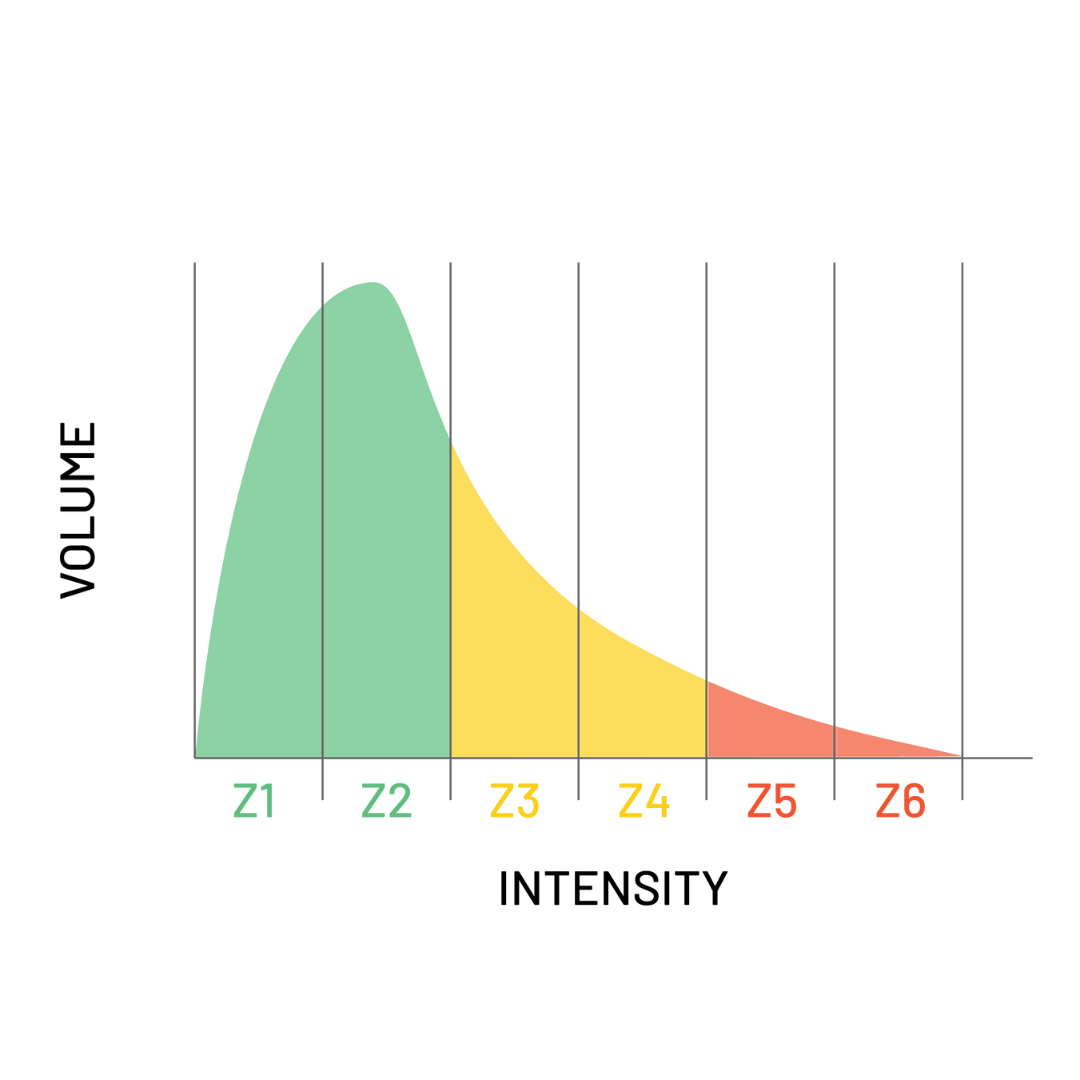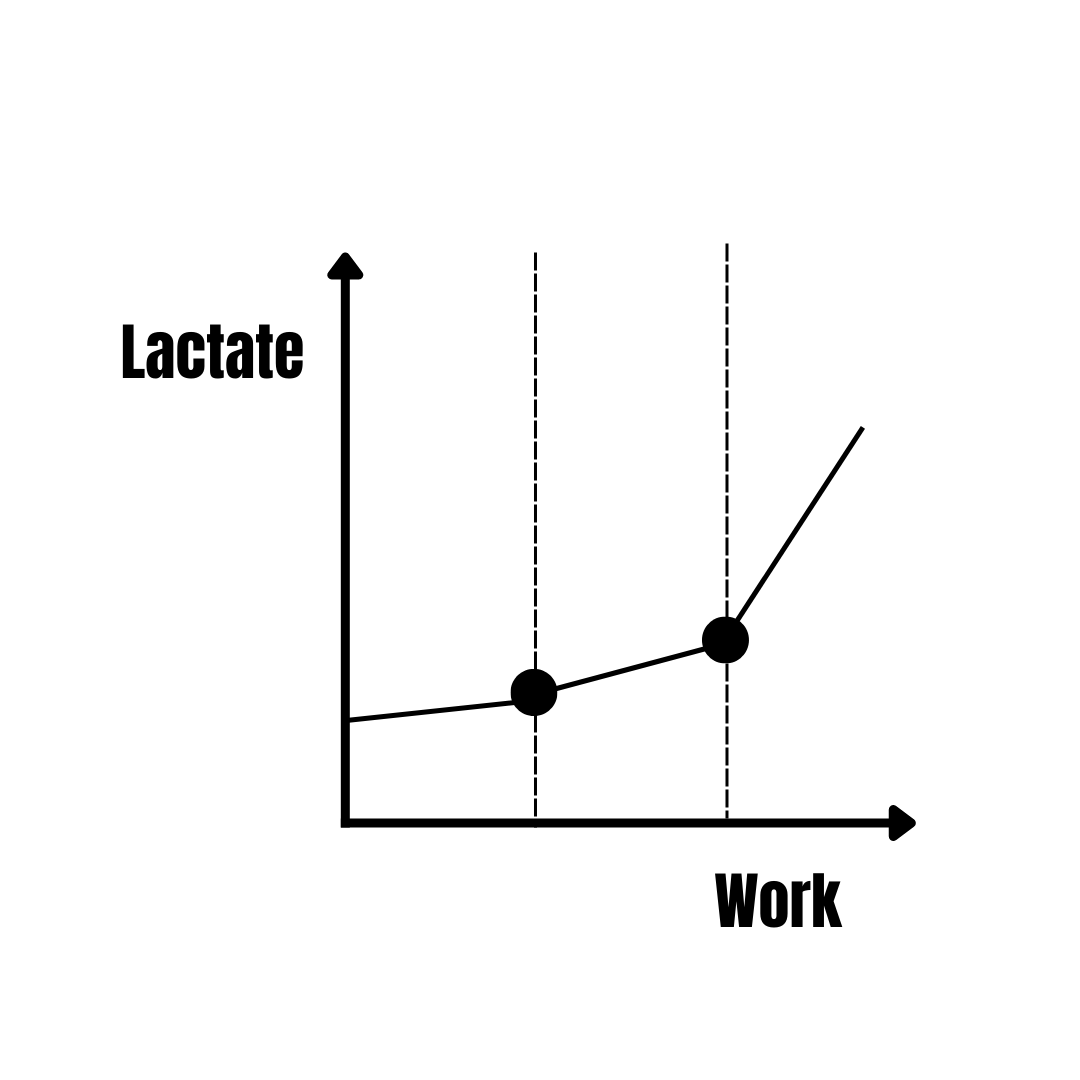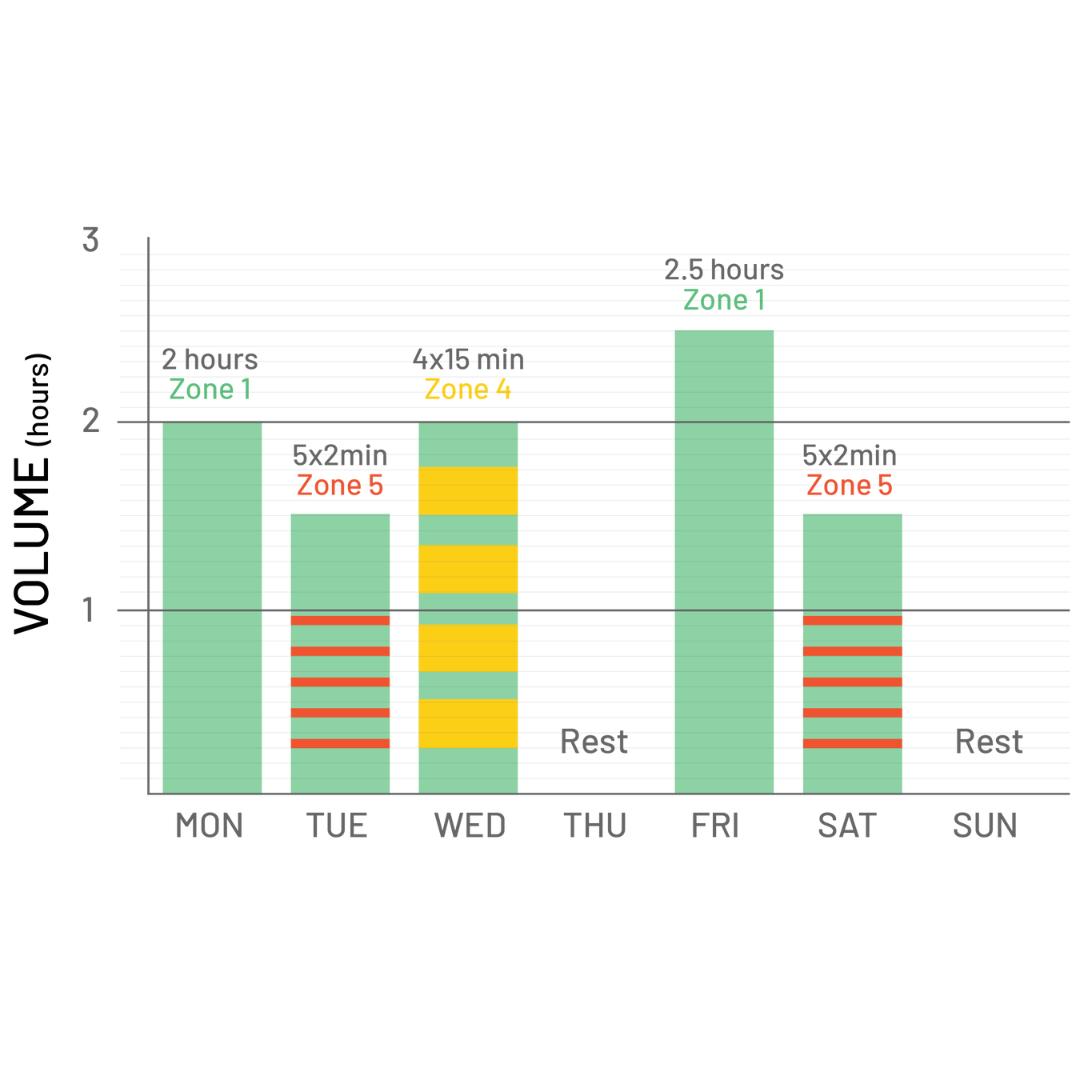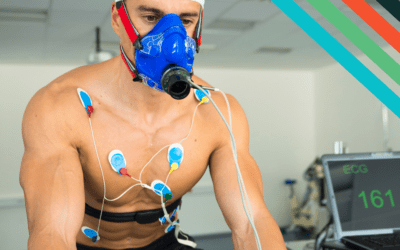Introduction
Often people refer to their “threshold” in the running world. But, as exercise physiologists, we know that there are actually two thresholds, the aerobic threshold and the anaerobic threshold, both with different purposes, physiologies, and work loads.
While most people refer to their “threshold” as the anaerobic threshold, and despite many new & seasoned runners having heard about the aerobic threshold, people tend to either forget about this threshold, or just have no idea what its purpose is. The poor aerobic threshold tends to live in its big sister, the anaerobic threshold’s shadow! When put on the spot, most people have no idea what the aerobic threshold is or where it is.
The aerobic threshold is the highest exercise intensity at which the body can maintain predominantly aerobic metabolism, where the body transitions from burning mostly fat to increasingly using carbohydrates for energy. Knowing your aerobic threshold is an important metric for ensuring that you’re getting enough running volume in specific zones so that your training is optimized and ultimately so that your performance improves!
So a few problems arise: how do we know where our aerobic threshold is? How can we track if it’s changing over time? How much is it supposed to change over time? What types of workouts can I do to improve my aerobic threshold? Perhaps you’ve been told by friends or other fellow runners: “Just run at a pace you can still hold a conversation at.” But, you don’t find that helpful advice. And, some days, you can hold a conversation at faster paces, and sometimes you feel like you need to go slower to chat. So where is this elusive thing?
Here, we explore the ins and outs of the aerobic threshold and answer some of these hard questions about the aerobic threshold! Stay until the end to get some sample aerobic workouts you can try.
Quick Navigation
- Introduction
- What is the Aerobic Threshold?
- Free Endurance eBook
- The Aerobic System related to various sports
- What’s the main purpose of Aerobic Threshold training?
- What is the 80/20 rule for endurance training?
- How can we find the Aerobic Threshold?
- How does it change over time?
- How a week of training might be laid out
- Free Lactate Testing eBook
- Sample Aerobic Threshold workouts
- Benefits of Aerobic training
- Conclusion
- About the author
- References
Stephen Seiler, an exercise physiologist in Norway, has extensively studied the 80/20 approach to training across a wide range of endurance athletes, which simply put is the training methodology focusing on aerobic, low intensity work. He explains the 80/20 rule saying, “Training is about integrating intensity and accumulating duration – we think an important advantage of doing more low-intensity training is that we signal adaptations without incurring too much systemic stress.”
What is the Aerobic Threshold?
Unlike the other energy systems, the aerobic system allows the resynthesis of ATP in the presence of oxygen, meaning that it can resynthesize energy through the breakdown of glucose, fat and protein. For this process to happen, the required amount of oxygen must be transported to the muscle cells, which require an increased heart rate and in the rate of breathing. Unlike the anaerobic lactic system, the aerobic system produces little or no lactic acid, thus enabling the body to continue to exercise. As a result, the aerobic system is the primary energy source for events lasting from just over one minute to three hours of prolonged work. Beyond two hours of work may result in the breakdown of fat and protein substances that are needed to replenish ATP as the body’s glycogen supply is depleted. (Bompa & Buzzichelli, 2005).
The aerobic threshold is often defined as the point at which during an incremental exercise test, there is more than a 1mmol/L rise in lactate about base levels or around the 2mmol/L mark for most individuals. It is sometimes called “LT1” or “VT1” whereas the anaerobic threshold is called “LT2” or “VT2” (LT=lactate threshold; VT=ventilatory threshold). Past the aerobic threshold, we are in what is typically called the “junk zone” of endurance training, or the small range of intensity between the aerobic and anaerobic thresholds. Most endurance athletes tend to spend too much time in this “middle ground” of training between aerobic and anaerobic training, and not enough time below the aerobic threshold.
An exception to this rule is in elite ultramarathoners, who tend to know that the intensity needed to sustain their efforts over the course of hours or days, tends to be in the area below the aerobic threshold!
The Aerobic System Related to Various Sports
Coaches without real knowledge of energy systems often intuitively develop programs that train the dominant energy system for the sport for instance, sprint coaches intuitively train their athletes with sprint distances. Endurance coaches intuitively train their athletes in long distances. However, in mixed sports like running a 5k (not quite a sprint, not quite long distance), playing hockey (some speed, some recovery), or soccer (lots of running, also change of direction and intermittent sprinting), there are many different energy systems working.

(Table adapted from Bompa & Buzzichelli, 2006).
Although most sports fall somewhere along a continuum of varying energy system contributions. Team sports like martial arts, racquet sports and court sports like volleyball tend to be characterized by intermittent activity. In these sports all three energy systems are used according to the intensity, rhythm and duration of the competition. Most of these sports use the anaerobic energy pathway during the active part of competition, but rely on strong aerobic power for quick recovery and regeneration between actions. As a result, the sport category requires a high proportion of training dedicated to improvement, maximum strength power and power endurance (Bompa & Buzzichelli, 2005).

But can these sports benefit from doing any aerobic threshold work? Or focusing on their aerobic threshold at all? Well the physiological limiters to performance of most sports, and these team-type and intermittent mixed sports are no different, are:
- The local endurance of a given muscle group (determined by the strength, energy stores, and density of capillaries in a given muscle group)
- The general endurance of the whole person (determined by strength, energy stores, cardiorespiratory fitness – the heart, lungs, and transport of oxygen – and the buffering capacity of the blood (Kurz, 2001).
So while maximum strength, power, and power endurance are crucial for some of the high intensity team and mixed sports, having the ability to recover from fast and hard efforts through the re-synthesis of ATP, the removal of metabolites through the blood, and the metabolism of lactic acid into pyruvate and back through aerobic metabolism, is a key factor for performance.
What’s the main purpose of Aerobic Threshold training?
Aerobic threshold training is intended to increase an athlete’s aerobic capacity, which is vital in many sports, especially those with the oxygen supply functions as a limiting factor for performance such as medium and long duration running, swimming and rowing. This type of training develops the efficiency of the cardiorespiratory system and the functioning of the metabolic system to increase the athletes capacity to tolerate stress for long periods of time.
The purpose of aerobic threshold training is to increase aerobic capacity through the use of high volume work either without interruption at a uniform pace or through interval training with long reps over 10 minutes at intensities of moderate to medium fast speed. Typically, during aerobic threshold training, we want to see lactic acid concentrations of two to three mmol/L with a heart rate of about 130 to 150 beats per minute.
Famously, the Ingebrigsten brothers who are trained by their father, use lactate thresholds to determine their training intensities, and it seems to be working as all three Norwegians seem to be performing extremely well on the world stages.
What is the 80/20 rule for endurance training?
While there is generally speaking an agreement between researchers and physiologists on the limiting factors of endurance activities, debate remains hot about how the daily training should be organized to maximize performance. Specifically, exercise intensity and its distribution remain the most critical and heavily debated (Seiler & Kjerland, 2006).
The two main ways that endurance training tends to be organized can be called a) the threshold training model whereby most of the training is performed around the lactate threshold (the second threshold), or b) the polarized model whereby the majority of training (80%) is organized below aerobic threshold, very little is between aerobic and anaerobic thresholds, and a little (20%) is above anaerobic threshold.
An observational study by Seilier and Kjerland (2006) studied the intensity distribution in eleven highly trained junior cross-country skiiers. Cross-country skiers tend to have the highest recorded endurance out of any other sport, on average (McArdle, Katch & Katch, 2010). They found that the training performed by these athletes was clearly 75% below aerobic threshold, and about 20% above anaerobic threshold, which was consistent with other observational studies of endurance athletes.
The polarized training model emerged from some other published observational studies of international rowers, gold medal winning time-trial cyclists, and internationally elite marathoners (Billat, 2001). These athletes would train a surprisingly little amount of time at their anaerobic threshold. The polarized model, as arranged graphically, in a 6-Zone model, might be arranged something like this:

Now – knowing the training distribution is of course only half the battle. You can’t just train for 10 minutes per week – 8 minutes below aerobic threshold and 2 minutes above anaerobic threshold, and expect to get any fitter. When examining the training volume of elite endurance athletes, distance runners typically trained 500h per year, and rowers, swimmers, and cyclists typically doubled that, with about 400-800 annual training sessions (Tnønessen et al, 2014). Yes, that’s an average of 1.1-2.2 training sessions PER DAY.
This approximate ‘‘80–20’’ distribution between low and high intensity training among high-level performers is a robust finding, even if explanations remain speculative. Furthermore, the ‘‘best practice’ magnitude and distribution of high intensity training (HIT) above the anaerobic threshold remains unclear.
Of note, is that the training-dose response relationship has a significant individual variation component, which further complicates the generalizability of the picture. While the influx of descriptive data on the training of elite endurance athletes has informed training practice, remember that MOST athletes are not elite. This is where an educated coach comes into the picture.
How can we find the Aerobic Threshold?
Even if you’re not yet elite, or even if you are, but you don’t have elite access to testing, or are trying to learn more about your training, a good next question we can ask is, how can we find the aerobic threshold? While there are many ways to find the aerobic threshold, the best way is to test for it in a lab.
In exercise physiology labs, we run people through what is called an incremental exercise test. This means that they start exercising at a very easy pace, usually for 3 minutes, and we take information like their heart rate, their rated perceived exertion (RPE), their blood lactate, and sometimes also their oxygen consumption and carbon dioxide excretion. With this information, we create graphs that help us determine where the “inflection points” occurred in their effort. These inflection points (there are 2) represent aerobic threshold and anaerobic threshold.

Where does the aerobic threshold occur during incremental exercise? For most people, it occurs at low levels of activity. It is the point at which your resting lactic acid production (which occurs at all times) raises past resting levels. For lay people, this might happen at low intensities, such as walking the dog, but for elite athletes like ultramarathoners, this pace is usually a run. For example, one of our clients Dave Proctor is currently running across Canada in an attempt to break the land-speed record, and his running pace is around 6-6:30 minutes/km most days. For some, that is a pace they couldn’t sustain for 5 minutes. For him, he runs it for 105km every day with hundreds to thousands of meters of elevation each run. He’s currently half way across Canada, with 66 consecutive days of running planned!
Are there other ways to figure out our aerobic threshold? There are technically a few different ways:
A) In a lab: we can do a VO2max test and find it through RER (respiratory exchange ratio), VE (ventilation) or VCO2 (volume of carbon dioxide exhaled.
B) In the field with lactates or heart rates: we can take the lactate measuring devices into the field if we have access to them. They are very portable, and then during workouts we can analyze blood lactate measurements to determine if the workout efforts match the workout purpose. For example, you could be doing aerobic repeats, and if we measure your lactate, we would expect a measurement below 2 mmol/L. If it was 1.5mmol/L we could ask the athlete to speed up, and if it was over 2, we would get them to slow down for the efforts.
C) Based on this perceived exertion scale. This scale is valid and reliable and though we added the faces for an added visual of the efforts, Seiler and Kjerland (2006) use the same one to determine training distributions.

D) With the talk test, most people without access to a lab can get a similar guide to how hard they should be working. In general, the aerobic threshold is around the point where you could talk but not sing during your training.
E) Of course, we can also estimate how hard you should be working based off of heart rates. If you know your max heart rate (HR), we can calculate an estimated % of max that the aerobic threshold should occur at, and give you that information to base your workout on. There are reasons why this might be less accurate or more volatile on a given day. There are other, slightly more accurate calculations we can do if we also know the athlete’s resting HR.
How does it change over time?
Now full disclosure, I’ve taken this sample graph created by one of my former professors, Dr. Smith, and copied in a scan of his notes here. I could not find access to the Jones article he referenced here. I love this example that was given, and although it is a little hard to see, try to make out the changes in lactate curves over the years for the elite marathoner, Paula Radcliffe, who was had her thresholds measured via an incremental exercise test in the lab over the years that she was training and competing.

You’ll notice that over the years her lactate curve shifts rightward. This is what we expect to happen as fitness and endurance improves in general. The rightward shift indicates a lower blood lactate (less reliance on the anaerobic system for energy production) for a given speed. Where once 19km/h would have been an all-out sprint effort for Paula, towards the end of her career, it marked a sustainable hard effort.
A good rule of thumb if you’re going the lab-route is to test and re-test every 3-4 months and/or after a big training block or an altitude training camp. In this period of time, after a concerted effort and specific training block, we should see your aerobic and anaerobic thresholds change. If they aren’t changing, this is a good time to re-evaluate the training with your coach.
How a week of training might be laid out
Below is a sample week of training where the athlete is doing about 80% of their volume in the “green” or “sub aerobic threshold” intensity. This amount of volume would be dependent on the individual athlete, as elite marathoners like Eliud Kipchoge is reported to do over 200km weeks of training, whereas someone just starting to train for their first 5km race might not hit 20km weeks in their build-up phase.

The number and structure of interval training, and the total volume of work will of course vary based on our individual assessment of the athlete’s needs, history, and current training status and injury history.
Sample aerobic threshold workouts
Want to try out an aerobic threshold workout? First, calculate your aerobic threshold. A rule of thumb I was once taught was to start with your maximum heart rate and to subtract 40-45 beats. I believe that is a better estimate for more mature endurance athletes who typically have lower maximum heart rates from all their training volume!
Another way is to use the traditional method and use 55-65% of your max heart rate. In order to find your max heart rate, you would need to strap on a heart rate monitor, and do a very hard effort of continuous exercise over 3 minutes or so (as heart rate sometimes takes awhile to reach its peak, even when the effort is super high). You could also learn to take your pulse and use a watch to estimate your max heart rate.
My max heart rate is around 195bpm, so with the traditional method, the math would be:
195*0.55 = 107 bpm
195*0.65 = 127 bpm
If I go with subtracting 45 beats from my max, that gives me a heart rate of 140bpm which is a little different from the % based calculator. Most of the endurance athletes I have tested do have their aerobic threshold around 120-150bpm but that doesn’t mean the same is necessarily true for you. The best way to test your aerobic threshold is in a lab setting, with blood lactate being measured, so that the physiologist can tell exactly when you go from sub-threshold, to between aerobic and anaerobic threshold!
Here are three sample workouts that will help improve your aerobic threshold and recovery.
1. Aerobic Threshold Workout: best done using cyclical/repetitive movements like running, cycling, rowing, or swimming.
- We know that aerobic threshold training is used to train the pace right at aerobic threshold, or as used as a recovery intensity between harder intervals. This pace can also be repeated as an interval-type session such as 20 minutes at 70% MAP followed by 2 minutes at 50% MAP; repeated in series. The number of intervals will be dependant on your current fitness level.
- Using approximately 70% MAP (maximal aerobic power or power at VO2max), this intensity will feel moderately hard due to the length of the workout, rather than the intensity. If you have a recent VO2max test in the same mode as your workout, you can use this estimated intensity
- If you’re using a heart rate monitor, train at approximately 65-75% of max heart rate
- The length of this session can be 10 minutes (or 10 minute intervals) to 2 hours continuous.
- Use the RPE scale shown in happy and sad faces above if you have neither a recent VO2max test or a heart rate monitor
2. Sub Aerobic Threshold Run or Ride. This could also be done in other modes such as rowing, swimming or light circuit training that is full-body in nature.
- This workout is less for recovery after another session, and more designed to train your aerobic threshold to increase, and to train specific paces for long-distance events. If you’re a triathlete, runner, or long-distance swimmer for example, include these workouts frequently in your training.
- Work out at approximately 60% MAP (maximal aerobic power or power at VO2max). Use this method if you have a recent VO2 max test that matches the mode of the workout you’re doing
- The intensity should be approximately 55-65% of max heart rate. Use 220 minus your age to estimate yours.
- The length of this session should be between 30 minutes to 8 hours of continuous training with little or no rest
3. Sub Aerobic Threshold Recovery Run or Ride. This could also be done in other modes such as rowing, swimming or light circuit training that is full-body in nature.
-
- This sub-aerobic threshold work is good for recovery between sessions, after a race, or after hard anaerobic threshold or strength work
- Work out at approximately 50% MAP (maximal aerobic power or power at VO2max). Use MAP if you have data from a recent VO2max test
- If you don’t know your MAP, use a heart rate monitor and train at approximately 45-55% of max heart rate. Use this calculation to estimate your max heart rate if you don’t know it:
220-age= estimated max heart rate - Duration of the workout should be 10 minutes – 40 minutes of work with short or no rest periods between sets.
4. Interval work. Perhaps you’ve heard that intervals are another way to improve your aerobic thresholds – and that is absolutely the case! Though it is beyond the scope of this article – subscribe to our blog below for free training advice in the future when we talk more about anaerobic threshold, intervals, and sample training regimens.
Benefits of aerobic training
According to the literature, there are a plethora of benefits to aerobic training. Things like capillary density, more mitochondria, and increased plasma volume can be gained as a result of this training. As well, your respiratory oxidative capacity is improved with this type of work.
On a more broad level, the health benefits of aerobic training are even more important today than ever before. Our population is trending towards more and more inactive lifestyles which present increased risk of chronic degeneration diseases (like multiple sclerosis, dementia, and others), cardiovascular diseases (coronary artery disease, stroke, hypertension), metabolic (obesity, diabetes), and bone diseases (osteoporosis).
Physical activity, and more specific aerobic training improvements, have been associated with decreases in all of the above diseases, as well as the prevention of their development.
Conclusion
While anaerobic threshold tends to get more of the spotlight than our aerobic threshold in general, it is important to understand how to test, measure, and improve the aerobic threshold over time. Too much focus on training intensity and volume, and not enough on lower intensity work can not only create excessive fatigue in the system, but might also miss the mark in terms of training your physiology to maximally benefit your sport or life. The various benefits not only to endurance athletes, but also power athletes, and the general population, makes aerobic endurance training a modality that’s here to stay.
For more of our free content, subscribe below to get weekly updates on what we’re reading and writing about. Or watch the video below to “meet me”!
References
Billat, V. L. (2001). Interval Training for Performance: A Scientific and Empirical Practice Special Recommendations for Middle-and Long-Distance Running. Part I: Aerobic Interval Training. In Sports Med (Vol. 31, Issue 1).
Billat, V. L., Demarle, A., Slawinski, J., Paiva, M., & Koralsztein, J. (2001). Physical and training characteristics of top-class marathon runners. In Med. Sci. Sports Exerc (Vol. 33, Issue 12). https://www.acsm-msse.org
Bompa, T. O., & Buzzichelli, C. (2005). Periodization training for sports (Vol. 3).
Gibala, M. J., Little, J. P., van Essen, M., Wilkin, G. P., Burgomaster, K. A., Safdar, A., Raha, S., & Tarnopolsky, M. A. (2006). Short-term sprint interval versus traditional endurance training: Similar initial adaptations in human skeletal muscle and exercise performance. Journal of Physiology, 575(3), 901–911. https://doi.org/10.1113/jphysiol.2006.112094
Kurz, T. (2001). Science of Sports Training (1st ed., Vol. 1). Stadion Publishing Company, Inc.
William D. McArdle, Frank I. Katch, & Victor L. Katch. (2010). William D. McArdle, Frank I. Katch, Victor L. Katch – Exercise physiology_ Nutrition, energy, and human performance (Emily Lupash, Ed.; 7th ed., Vol. 7). Lippincott Williams & Wilkins.
Seiler, K. S., & Kjerland, G. Ø. (2006). Quantifying training intensity distribution in elite endurance athletes: Is there evidence for an “optimal” distribution? Scandinavian Journal of Medicine and Science in Sports, 16(1), 49–56. https://doi.org/10.1111/j.1600-0838.2004.00418.x
Tnønessen, E., Sylta, Ø., Haugen, T. A., Hem, E., Svendsen, I. S., & Seiler, S. (2014). The road to gold: Training and peaking characteristics in the year prior to a gold medal endurance performance. PLoS ONE, 9(7). https://doi.org/10.1371/journal.pone.0101796
Wilmore, J. H. (2003). Aerobic exercise and endurance: Improving fitness for health benefits. In Physician and Sportsmedicine (Vol. 31, Issue 5). McGraw-Hill Companies. https://doi.org/10.3810/psm.2003.05.367




